The Continued Decline of the First-Pitch Fastball
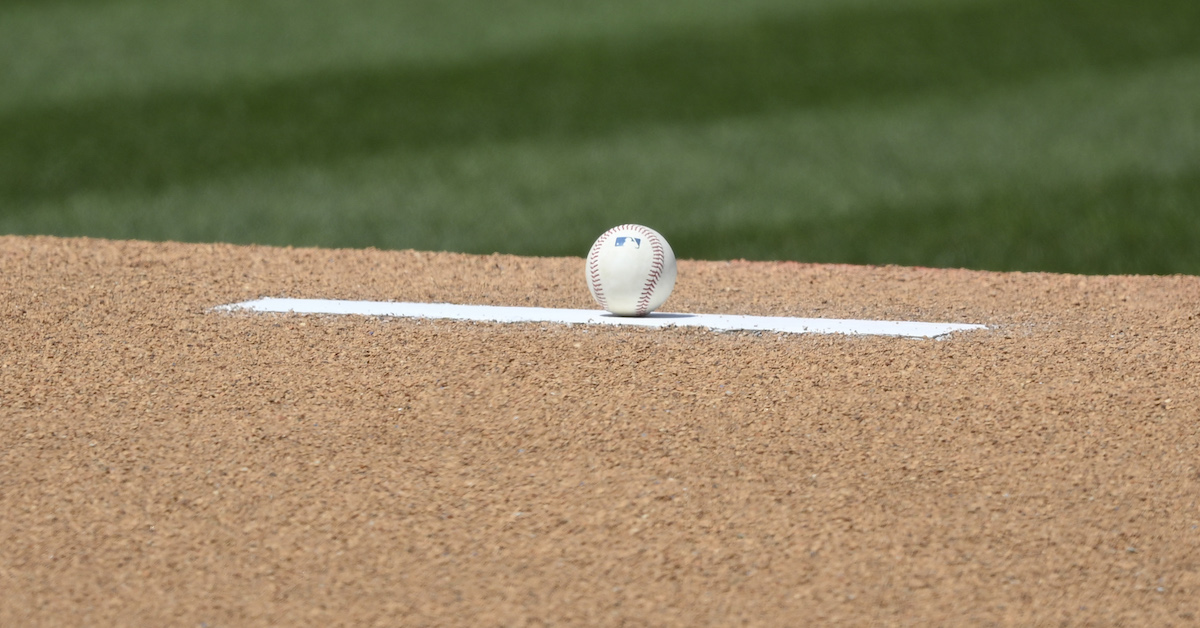
Back in my day — the mid-2000s — baseball was a simpler game. Batters socked dingers, with or without the use of performance-enhancing drugs. Teams batted slap hitters second, fast hitters first, and aging sluggers third. Catchers were valued by their bat and their throwing arm, none of this framing nonsense. And pitchers? Pitchers helped everybody out by throwing fastballs all the time, particularly on the first pitch. Seriously, take a look at this graph:
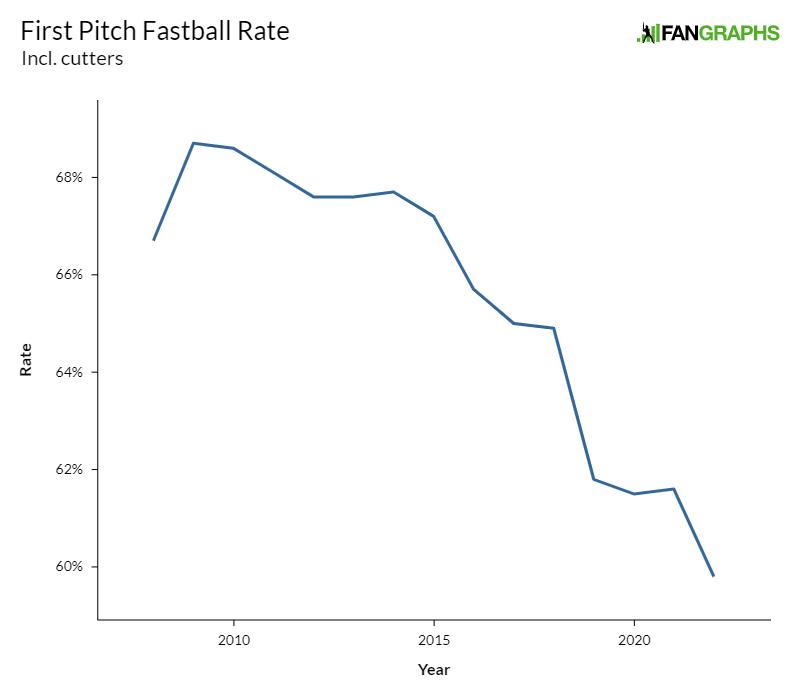
Year after year, pitchers have examined the mix of pitches they throw to lead off at-bats and decided to lop a few fastballs off the top. It’s not quite monotonically decreasing; there have been tiny upticks in a few years, and 2008 was lower, potentially due to classification issues in the first year of data. But this is as close as a trend can get to slapping you in the face.
The first pitch of an at-bat isn’t always the most important one — in a 3–2 count, one borderline pitch can be the difference between a baserunner and an out — but the difference between a 1–0 count and an 0–1 count is huge. That’s why pitchers have historically leaned on fastballs, which are easier to control; throwing a pitch outside the zone is a sure way to end up behind in the count.
A fastball’s greatest weakness is also mitigated on the first pitch of an at-bat. Fastballs are easy to hit, on a relative basis: they move less! Pretty much every major league hitter can hit a fastball if they’re looking for one. Since 2008 (the start of our pitch-level data), batters have produced a .372 wOBA when they put a fastball in play, as compared to .350 on every other pitch. They’ve missed less often, too: a 17.2% whiff rate on fastballs and 31.7% on all other pitches.
On the first pitch, though, batters swing less often, even at inviting fastballs. Take a look at how often hitters across the league have swung at 0–0 fastballs, as well as fastballs in all other counts:
| Year | 0-0 Swing% | All Other Swing% |
|---|---|---|
| 2008 | 27.7% | 51.6% |
| 2009 | 26.4% | 51.4% |
| 2010 | 25.9% | 51.6% |
| 2011 | 26.6% | 52.1% |
| 2012 | 26.5% | 52.0% |
| 2013 | 27.0% | 52.6% |
| 2014 | 27.4% | 52.8% |
| 2015 | 29.0% | 53.1% |
| 2016 | 28.6% | 52.8% |
| 2017 | 29.0% | 52.9% |
| 2018 | 29.2% | 53.0% |
| 2019 | 30.4% | 53.0% |
| 2020 | 29.4% | 52.1% |
| 2021 | 30.9% | 53.5% |
| 2022 | 31.2% | 53.2% |
Batters have mostly been letting pitchers get away with it, though that’s changing in recent years. But an extra 5% of swings replacing takes is a problem for pitchers, because those fastballs are at their best when they’re taken. And if we limit our data to only fastballs in the zone, the increase is far more pronounced:
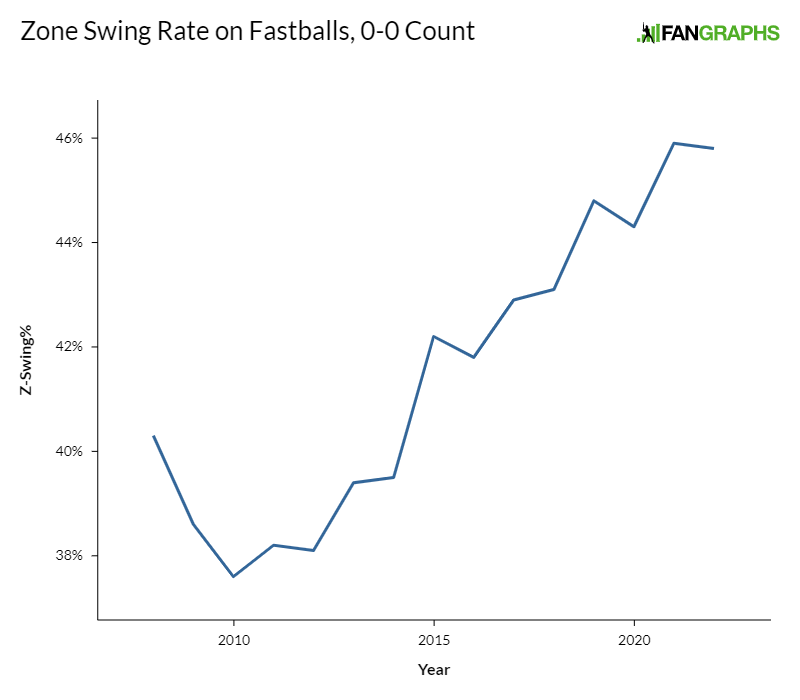
The 2008 season again looks weird, but in general, hitters are no dummies. It’s so hard to hit major league pitching, and hitters are taking their easy chances when they can get them, tagging fastballs in the strike zone whenever possible.
From a pitcher’s perspective, continuing to lob fastballs into the zone was untenable. Hitters are thinking swing on the first pitch. That’s always been an option against elite pitchers, but as it turns out, it’s pretty good against everybody.
This isn’t a new dance. I’ve written about it. The Hardball Times wrote about it in 2009 and then twice in 2013. Russell Eassom wrote about it on our community blog. Tom Verducci covered first-pitch aggression and its decline thereafter, though the article has been lost to the internet mists. Our own Jeff Sullivan wrote about the return of the first-pitch swing in 2015; Eno Sarris did too. But the trend of attacking first pitch fastballs is continuing to gain steam.
As much as the excess returns on swinging at fastballs have encouraged batter aggression, what they’re avoiding has mattered just as much. It’s downright hard to hit in an 0–1 count, which is what you end up with if you take a first-pitch fastball in the zone. And “in the zone” is likely; when pitchers do choose a fastball for their first offering, they’re throwing in the zone at the highest rate since we have had pitch-level data.
There’s another factor driving batters’ increased aggression. Since MLB moved to a livelier baseball at the 2015 All-Star break, putting a ball in play has gotten more valuable. First-pitch fastballs in the strike zone, in particular, work out better for hitters these days than they did in the early 2010s:
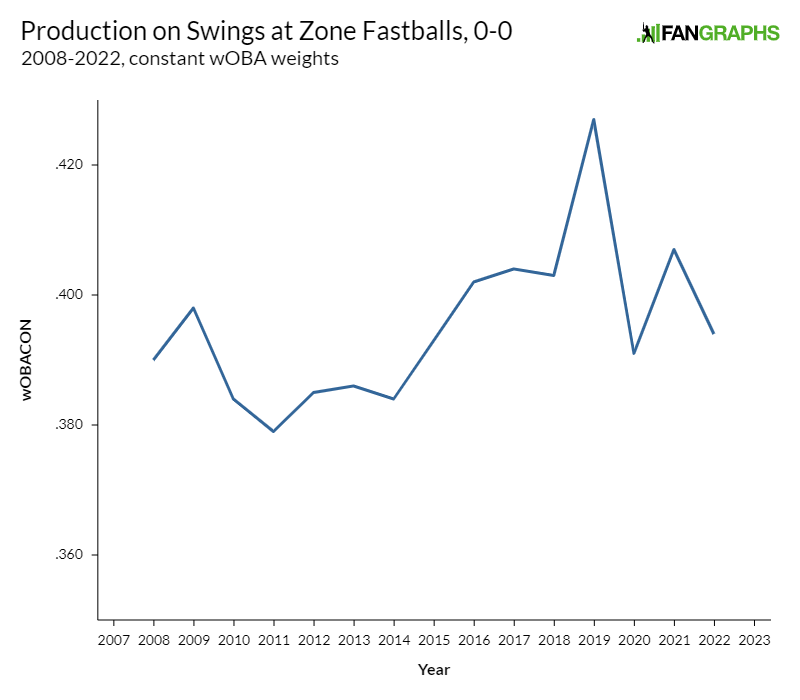
This year’s deader ball might presage a different dominant strategy, but in recent years, pitchers have been tempting fate when they challenge hitters. It’s no surprise, then, that they’ve stopped doing it so much.
One downside of swinging much more at fastballs: that aggressive mindset carries over into all first-pitch swings, and it’s a lot less fun to swing at breaking stuff when you’re expecting a fastball. In the last three years, batters have swung at 27.8% of first-pitch secondary pitches, up from 24.7% in the mini-deadball era of 2011–14. That doesn’t sound like a huge increase, but the confluence of more secondary pitches to start at-bats and more swings at those pitches is pretty weird if you think about it. Pitchers are throwing pitches with more movement, and they’re throwing those pitches in the strike zone less than they used to: 47.6% over the last four years, 50.2% from 2011 to ’14. Batters are still swinging more at them anyway. That’s just the cost of doing business, and it’s a worthy trade for a first-pitch fastball you can barrel up.
None of these are huge changes, but they’re all in the same direction. Batters are getting more aggressive against fastballs, and pitchers are countering by eschewing fastballs wherever they can. They’re also being smart about their pitch mix: more of their fastballs are in the zone, because a fastball out of the zone on the first pitch of an at-bat is a near-certain take, but more of their secondary pitches are out of the zone to take advantage of batter aggression.
The aggregate effect of these changes has been muted. Baseball Reference maintains a wonderful split: tOPS+ (basically situational OPS compared to overall OPS) after swinging at the first pitch of an at-bat. We can go further back here, since we don’t need pitch type data:
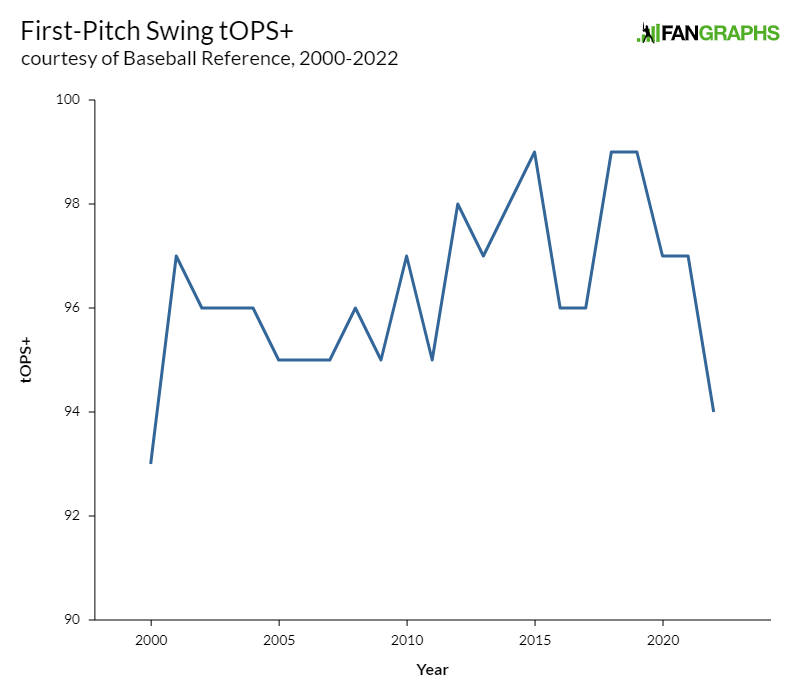
Batters haven’t achieved a 100 tOPS+ even once in these years, but that’s largely a selection issue. The pitches that batters don’t swing at are disproportionately balls, and starting in a 1–0 count is a big tailwind for hitters. If a pitcher isn’t doing his job — and throwing a fastball for a ball or bouncing a breaking ball on the first pitch definitely counts as dereliction of duty — a batter will take and get ahead.
It’s far more useful to compare tOPS+ to itself year over year to look for changes in relative production. And if we do that, we can see that the combination of a tilt toward more swings and a livelier ball briefly nudged results higher. This year’s mark, on the other hand, is the lowest since 2000, and plenty of things are causing that: less production on contact, more non-fastballs, and more swings than ever despite a tougher pitch mix.
Who has the edge in this battle? For now, I think it’s pitchers. What’s happening on the first pitch is a microcosm of what’s happening on every pitch. Fastballs are faster than ever, but they’re also rarer than ever. Hitters consistently rack up positive value against fastballs and bleed it away against secondaries; it’s an easy trend to grab a hold of if you’re a pitcher. That a hitter’s best escape is to hunt fastballs even more aggressively only accentuates the move.
But next time you watch a game, keep an eye on what pitchers are doing on the first pitch. Will it be a pipe shot fastball? Maybe; 18% of first pitches this year have been fastballs down the middle. But more than before, pitchers are thinking about what to throw and coming up with alternatives. Hitters will need to adjust, or find a way to lay off the secondary pitches without giving up too much value by taking strikes. And if you’re curious, we haven’t reached equilibrium yet; hitters have produced 25.6 runs above average (per Statcast run values) on first-pitch fastballs and lost it back against everything else. The path of least resistance is still toward fewer fastballs, even after we’ve moved all this way.
Ben is a writer at FanGraphs. He can be found on Bluesky @benclemens.

It feels like the Rockies haven’t gotten the memo on this. Early in games in particular, our starters just pour those first pitch fastballs in lol